You’re probably wondering which native plants can transform your Kentucky garden into a pollinator paradise without breaking your back or budget. Kentucky’s climate zone 6a-7a supports dozens of stunning native species that’ll thrive in your specific soil conditions, whether you’re dealing with clay, loam, or rocky terrain. The secret lies in matching each plant’s natural habitat requirements to your garden’s unique microenvironments, but first you need to understand what makes Kentucky’s native flora so remarkably adaptable.
Contents
- 1 Kentucky’s Diverse Soil Types
- 2 Colorful Kentucky Native Wildflowers
- 3 Shade-Providing Kentucky Native Trees
- 4 Kentucky’s Best Native Shrubs
- 5 Selecting the Right Native Plants for Your Garden
- 6 Frequently Asked Questions
- 6.1 When Is the Best Time to Plant Native Kentucky Plants?
- 6.2 How Much Do Native Kentucky Plants Typically Cost?
- 6.3 Where Can I Purchase Native Kentucky Plants Locally?
- 6.4 Do Native Kentucky Plants Require Special Fertilizers or Soil Amendments?
- 6.5 How Long Does It Take for Native Plants to Establish?
Kentucky’s Diverse Soil Types
When you’re selecting native plants for your Kentucky garden, understanding the state’s diverse soil types becomes your foundation for success. Kentucky’s varied geology creates distinct soil regions, with the famous Crider series covering 500,000 acres across 35 counties. These deep, well-drained soils display distinctive red coloring from iron oxides.
You’ll find soil composition ranges from limestone-derived soils in the Pennyroyal region to diverse types across different physiographic areas. The state’s soil classification system helps determine limitations for plant growth.
Understanding your specific soil composition supports effective soil conservation practices, ensuring your native plants thrive in their natural environment. The comprehensive Kentucky Soil Atlas serves as an invaluable resource for gardeners seeking detailed information about their local soil characteristics and management recommendations.
Colorful Kentucky Native Wildflowers
Kentucky’s native wildflowers offer stunning garden displays through vibrant blooms, seasonal variety, and ecological benefits while supporting local pollinators and adapting to diverse growing conditions. These native plants often require less maintenance and are naturally adapted to local environmental conditions, making them ideal choices for sustainable gardening practices.
Wild Bergamot

Wild Bergamot is a Kentucky native perennial that forms attractive clumps 2-4 feet tall with aromatic, gray-green foliage and square stems characteristic of the mint family. From mid to late summer, it produces striking rounded clusters of pale lavender to pink, two-lipped flowers that measure 2-4 inches across. This drought-tolerant wildflower thrives in prairies, rocky woods, and naturalized areas.
Beyond its ornamental value, Wild Bergamot serves as an excellent pollinator plant, attracting bees, butterflies, and hummingbirds while remaining deer resistant. The fragrant leaves and flowers are edible and have been traditionally used in herbal teas. Named Kentucky’s 2001 Wildflower of the Year, it makes an excellent addition to herb gardens, prairie plantings, and wildflower borders. The plant spreads naturally through underground rhizomes, creating larger colonies over time.
- Hardiness: Perennial in Kentucky (zones 3-9)
- Light: Full sun
- Water: Moderate to low; drought tolerant once established
- Soil: Well-draining; tolerates rocky, sandy, or various soil types
- Fertilizer: None required; thrives in native soil conditions
- Pest/Disease Resistance: Deer resistant; susceptible to powdery mildew and rust when stressed or crowded
- Growth Rate: Moderate; clump-forming
Purple Coneflower
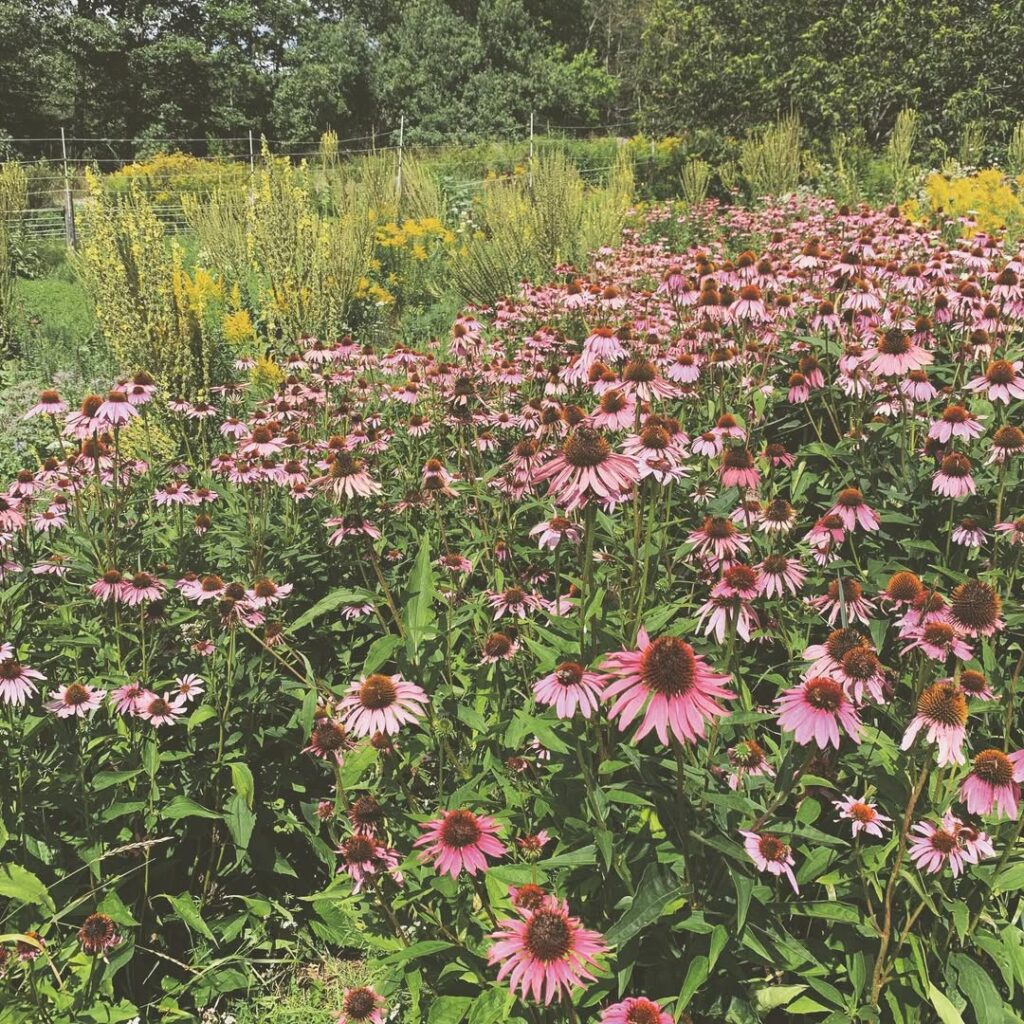
Purple Coneflower is a beloved Kentucky native wildflower that brings vibrant color and ecological benefits to local gardens. This hardy perennial produces distinctive flowers with spiny, purplish-brown centers surrounded by drooping lavender petals from June through August. Growing 1-4 feet tall with an upright habit, it creates attractive winter seed heads that persist long after blooming season ends.
As a native species grown from Kentucky-source seed, Purple Coneflower is exceptionally well-adapted to the region’s climate and growing conditions. It thrives in prairie gardens, borders, and naturalized areas while providing excellent cut flowers for arrangements. This low-maintenance perennial supports local ecosystems and attracts beneficial pollinators, making it an ideal choice for sustainable Kentucky landscapes. The plant serves as a larval host for the Silvery Checkerspot butterfly and Wavy-lined Emerald moth, further enhancing its ecological value in native gardens.
- Hardiness: Hardy perennial native to Kentucky, well-adapted to local climate conditions
- Light: Full sun to part shade
- Water: Medium water use; drought tolerant once established, withstands dry summers well
- Soil: Well-drained, sandy or richer soils preferred
- Fertilizer: Not heavy feeders; 12-6-6 slow-release fertilizer at 1 lb per 100 sq ft in late March/early April
- Pest/Disease Resistance: Good resistance with proper spacing for air circulation
- Growth Rate: Moderate; may become aggressive in ideal conditions
Black-Eyed Susan
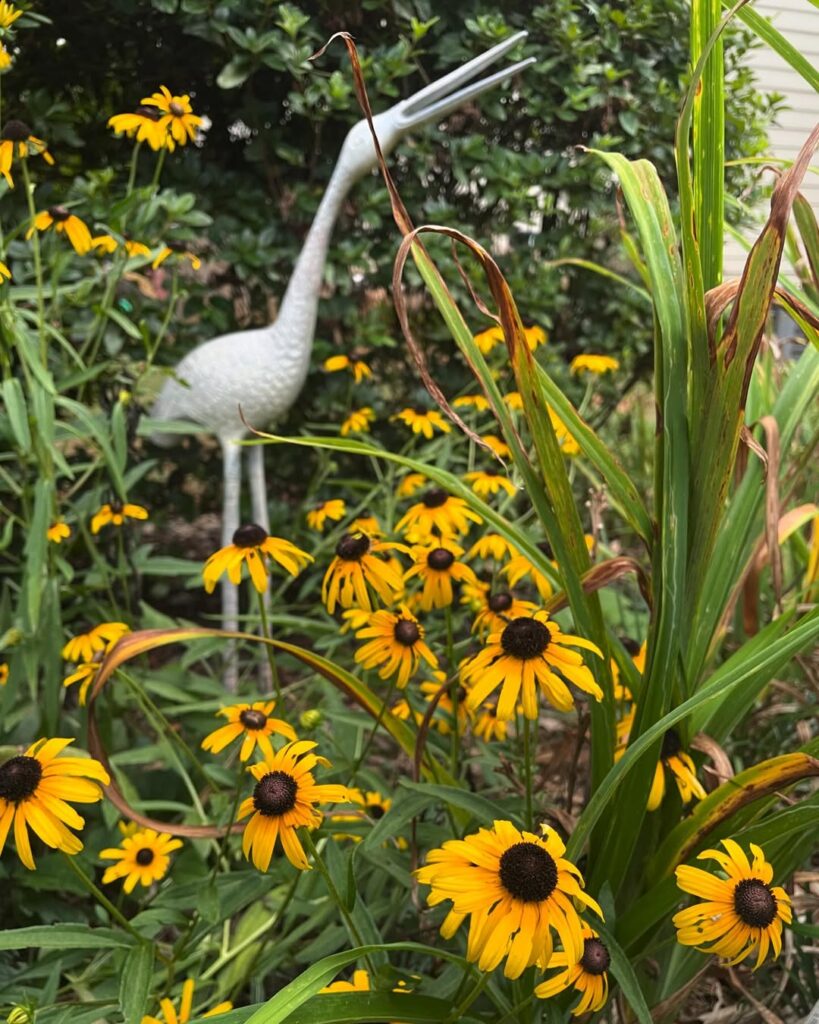
Black-eyed Susan (Rudbeckia hirta) stands as one of Kentucky’s most recognizable native wildflowers, gracing roadsides, meadows, and gardens with its vibrant yellow petals and distinctive dark centers. This hardy member of the daisy family blooms reliably from June through October, making it an invaluable addition to any native plant garden.
Beyond its striking appearance, Black-eyed Susan serves as an ecological powerhouse, attracting essential pollinators like bees and butterflies while providing seeds for finches and other birds. Its self-seeding nature and pioneer species characteristics make it excellent for naturalizing disturbed areas, though gardeners should monitor its spread in formal plantings. The plants produce cypsela fruits, which develop 3-4 weeks after the blooming period ends.
- Hardiness: Adapted across wide USDA zones; robust against Kentucky’s extreme summers and winters
- Light: Full sun preferred; tolerates some afternoon shade for extended blooms
- Water: Medium requirements; drought-tolerant once established
- Soil: Moist to dry, well-drained soils with acidic to slightly neutral pH; tolerates native Kentucky soil
- Fertilizer: Minimal requirements; thrives in average to poor soils
- Pest/Disease Resistance: Excellent; minimal issues except potential powdery mildew in humid conditions
- Growth Rate: Moderate to fast; self-seeds freely in favorable conditions
Wild Columbine
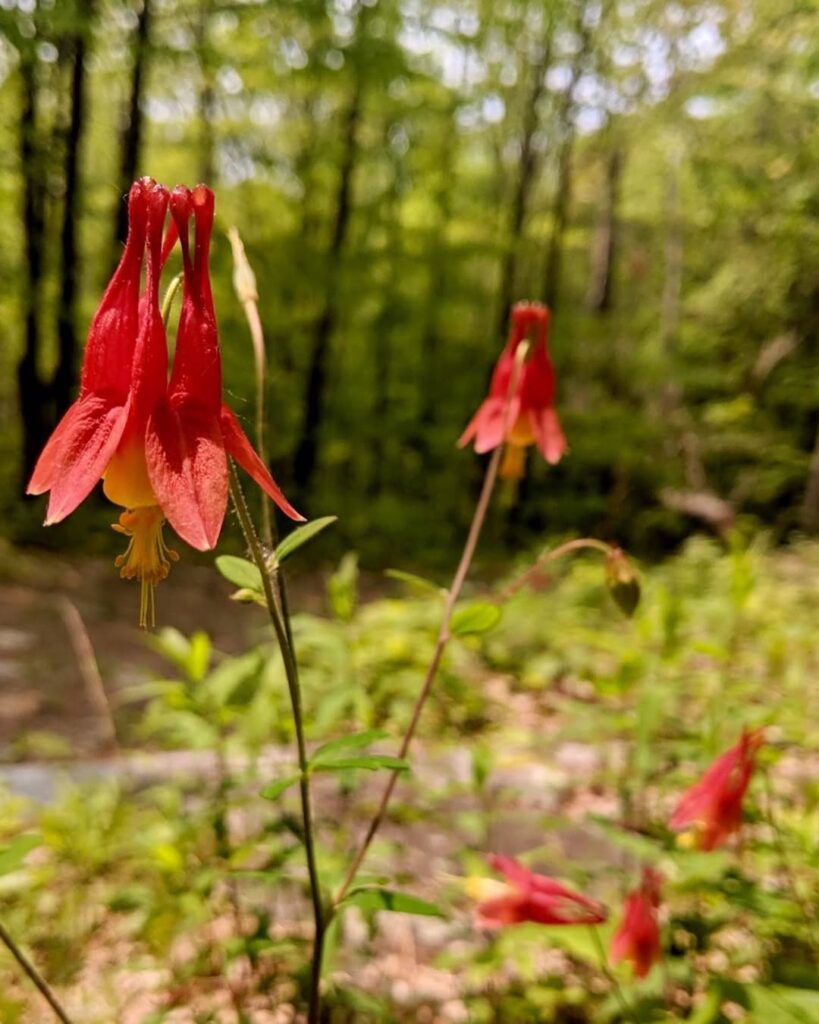
Wild Columbine is a striking eastern North American native that brings vibrant color to Kentucky gardens with its distinctive nodding, bell-shaped flowers featuring red sepals and yellow petals with upward spurs. This clumping perennial reaches up to 3 feet tall and spreads about 1.5 feet wide, offering nearly year-round foliage interest except in extreme temperatures.
Blooming from May through June, Wild Columbine serves as an essential early-season nectar source for hummingbirds, bees, and butterflies. The plant readily self-seeds in favorable conditions and develops attractive brown or green seed pods that split to release shiny black seeds. Its versatility makes it excellent for woodland gardens, pollinator plantings, and rocky slopes throughout USDA zones 3-8. This resilient native demonstrates exceptional drought tolerance once established, making it ideal for low-maintenance landscapes.
- Hardiness: USDA zones 3-8
- Light: Full sun to partial shade
- Water: Well-drained, moist to occasionally dry conditions
- Soil: Adaptable to clay, loam, and sandy soils with neutral pH (6.0-8.0)
- Fertilizer: Low requirements, thrives in native conditions
- Pest/Disease Resistance: Generally resistant with moderate maintenance needs
- Growth Rate: Medium growth rate with clumping habit
Cardinal Flower

The Cardinal Flower (Lobelia cardinalis) is Kentucky’s most spectacular native wildflower, earning recognition as “America’s favorite flower” for its brilliant scarlet blooms. Named after Roman Catholic cardinals’ red vestments, this striking plant produces tubular flowers from late June through September, with blooms progressing from bottom to top of stalks that can reach 2-6 feet tall.
This moisture-loving wildflower serves as a primary nectar source for ruby-throated hummingbirds, with its long tubular flowers perfectly designed for hummingbird pollination. The deep red blooms create stunning vertical displays in gardens and naturalized areas, though the plant requires consistently wet conditions to thrive and will quickly perish if allowed to dry out. Cardinal Flower may not return every year and is often treated as annual by gardeners who don’t provide optimal growing conditions.
- Hardiness: Perennial in Kentucky (zones 3-9)
- Light: Full sun to partial shade
- Water: Consistently moist to wet; does not tolerate dry conditions
- Soil: Rich, wet, poorly drained clay soil preferred
- Fertilizer: Low requirements in naturally rich, moist soil
- Pest/Disease Resistance: Generally good resistance when grown in proper conditions
- Growth Rate: Moderate; blooms for several weeks once established
Shade-Providing Kentucky Native Trees
Kentucky’s native trees offer exceptional shade solutions while supporting local ecosystems. From the towering Tulip Poplar to majestic Oaks, these species provide cooling canopies perfectly adapted to regional conditions. The White Oak stands out with its broad-spreading limbs and attractive leathery leaves, creating an impressive 80-foot canopy span that makes it ideal for large landscapes.
Eastern Red Cedar

The Eastern Red Cedar is a versatile native evergreen that brings year-round structure and wildlife value to Kentucky landscapes. This slow-growing conifer develops a dense, pyramidal crown that provides excellent shade and screening, making it ideal for windbreaks and privacy barriers. Its aromatic, blue-green needles and small bluish-purple berries add visual interest while supporting local wildlife.
Beyond its ornamental appeal, Eastern Red Cedar demonstrates remarkable resilience in challenging growing conditions. The species thrives in poor, rocky soils where other trees struggle, and its drought tolerance makes it an excellent choice for low-maintenance landscapes. The tree’s wood is highly prized for its beauty and durability, making it valuable for both crafts and commercial applications. While patience is required due to its slow growth rate, this native tree ultimately rewards gardeners with decades of reliable performance and ecological benefits.
- Hardiness: Zones 3-9
- Light: Full sun to partial shade; full sun preferred for peak density
- Water: Drought tolerant once established; minimal watering required
- Soil: Well-drained, rocky, limestone-based, or poor soils; highly adaptable
- Fertilizer: None required; thrives in nutrient-poor conditions
- Pest/Disease Resistance: Excellent; naturally resistant to most pests and diseases
- Growth Rate: Slow, typically less than 1 foot per year
American Basswood

American Basswood is a majestic native shade tree that can reach 60-80 feet tall with a broad, spreading canopy. Also known as American Linden, this deciduous tree features fragrant yellow flowers in summer that attract bees, earning it the nickname “Bee-tree.” The aromatic blooms and dense foliage make it an excellent specimen tree for large landscapes.
This adaptable native thrives throughout Kentucky’s varied conditions and provides exceptional wildlife habitat. Its fibrous inner bark was historically used by Native Americans for rope-making, while the soft wood remains valuable for crafting. The tree develops distinctive gray, furrowed bark and produces small nut-like fruits in fall. The blossoms yield a strongly flavored honey that is particularly prized by beekeepers.
- Hardiness: USDA zones 3-8
- Light: Full sun to dense shade
- Water: Moderate to high; prefers consistently moist conditions
- Soil: Adaptable to various conditions; prefers moist, well-drained soils
- Fertilizer: Low maintenance; benefits from organic matter
- Pest/Disease Resistance: Generally good resistance to most issues
- Growth Rate: Moderate to rapid
Sugar Maple
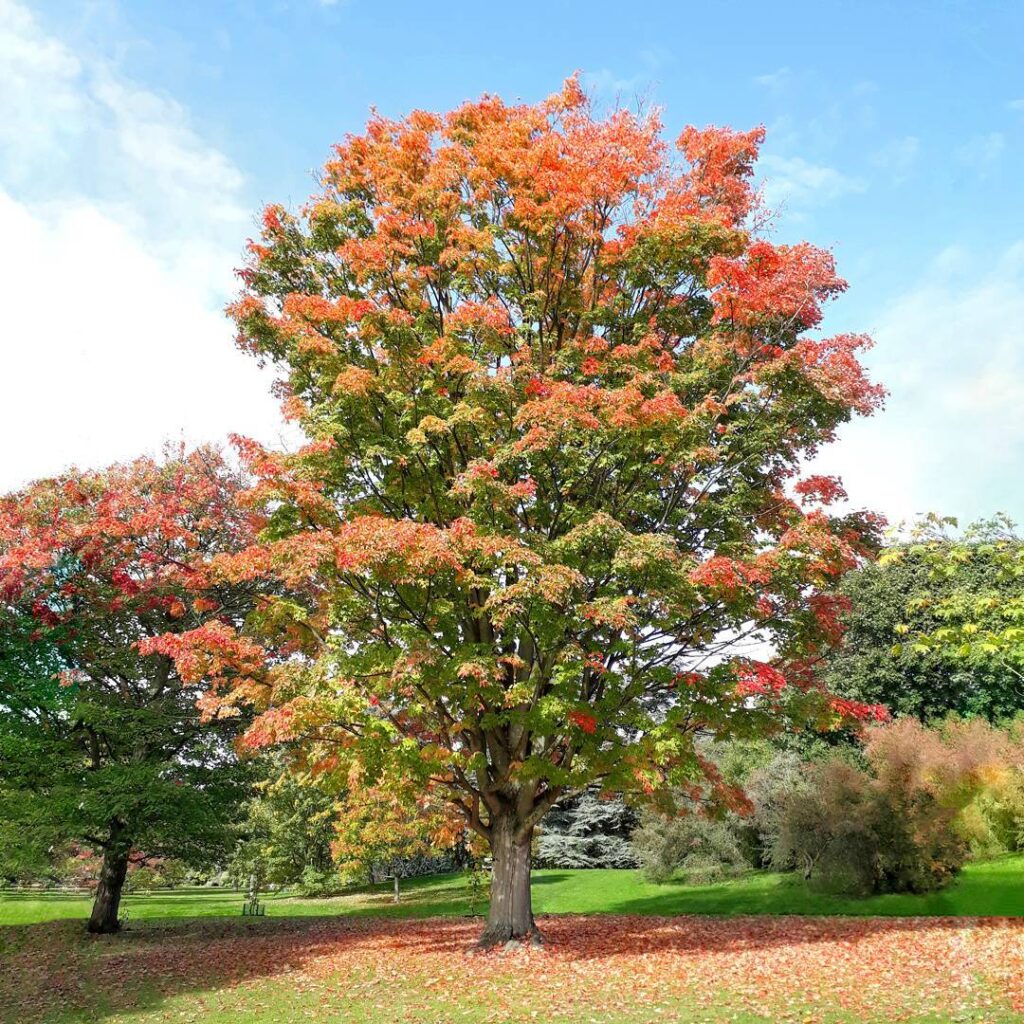
The Sugar Maple is a majestic Kentucky native that serves as an exceptional shade tree for large landscapes. Growing 60-75 feet tall with a 40-50 foot canopy spread, this deciduous hardwood develops an attractive oval to rounded crown. Its smooth gray-brown bark becomes characteristically scaly with age, while the iconic five-lobed leaves provide dense summer shade before transforming into brilliant displays of red, orange, and yellow each fall.
Beyond its ornamental value, Sugar Maple plays a crucial ecological role in Kentucky’s native woodlands as a dominant canopy species. The tree produces abundant wildlife habitat and food sources while contributing to forest biodiversity. As Canada’s national tree and a major source of maple syrup, this long-lived species combines cultural significance with practical landscape value, making it an ideal choice for parks, campuses, and spacious residential properties. The valuable wood is highly prized for furniture production, featuring special grain patterns like birdseye and curly maple.
- Hardiness: Zones 3-8, well-suited to Kentucky climate
- Light: Full sun to partial shade, highly shade tolerant
- Water: Moderate moisture requirements, drought tolerant once established
- Soil: Fertile, well-drained, slightly acidic soils preferred
- Fertilizer: Generally not required in suitable soil conditions
- Pest/Disease Resistance: Good resistance to most pests and diseases
- Growth Rate: Slow to moderate growth rate
White Oak
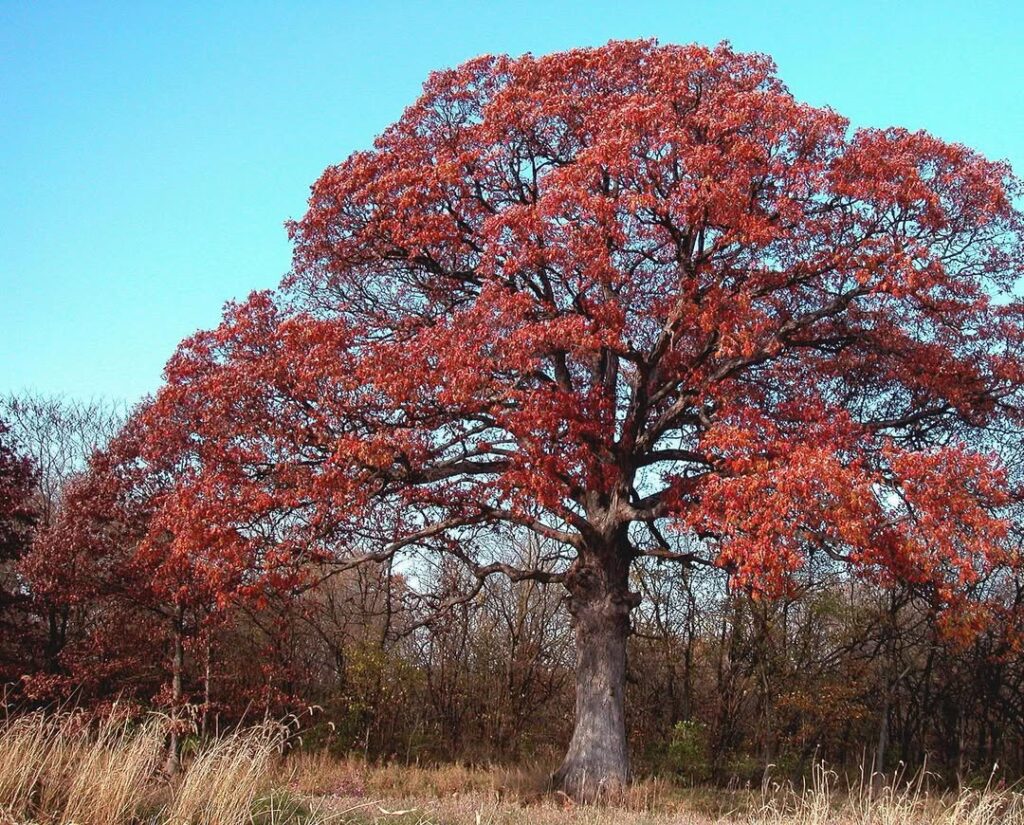
The White Oak stands as Kentucky’s premier native shade tree, capable of reaching impressive heights over 100 feet with a distinctive wide-spreading rounded crown. This majestic species features blue-green leaves with whitish undersides and deeply lobed margins, developing either a short stocky trunk in open areas or a tall straight bole in forest settings. Beyond its aesthetic appeal as a long-lived landscape specimen, White Oak serves as the most important tree for Kentucky wildlife, producing palatable acorns that feed deer, squirrels, turkey, and black bear.
With its potential lifespan of up to 600 years, White Oak creates a lasting legacy in Kentucky gardens while providing spectacular autumn color. The species produces wind-pollinated flowers from March to May, with distinctive yellow-green male catkins and reddish-green female spikes that develop into annual acorn crops up to one inch long. White oaks typically begin producing acorns around 20 years of age, making patience an important consideration for gardeners seeking wildlife benefits.
- Hardiness: Extremely hardy throughout Kentucky, tolerating various climate conditions
- Light: Full sun to partial shade, adapts well to different light conditions
- Water: Moderate water needs, drought tolerant once established
- Soil: Grows on wide range of soils throughout Kentucky, very adaptable
- Fertilizer: Low fertilizer requirements, thrives in native soil conditions
- Pest/Disease Resistance: Generally resistant with good overall health
- Growth Rate: Slow to moderate growth, averaging 3-5 cm diameter increase per decade
Tulip Poplar
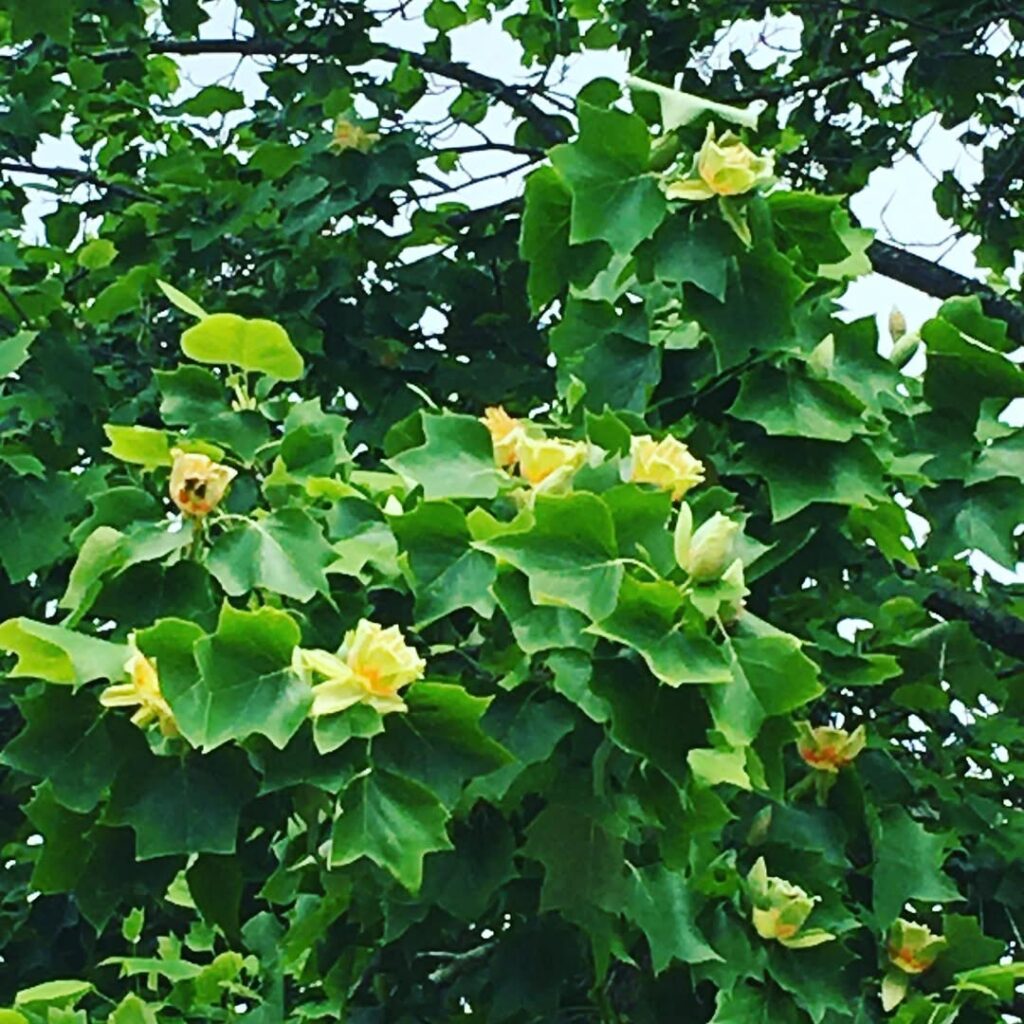
The Tulip Poplar stands as one of Kentucky’s most magnificent native shade trees, capable of reaching impressive heights of 70-90 feet with a distinctive pyramidal crown that spreads with age. This fast-growing deciduous tree features characteristic 4-lobed, star-shaped leaves that turn brilliant gold in fall, and produces striking tulip-like flowers with yellow-green petals in late spring. The tree’s smooth, dark green bark develops attractive white furrows as it matures.
Beyond its ornamental value, Tulip Poplar serves essential ecological functions as a major nectar source for Kentucky pollinators and produces prized reddish-brown honey. Its cone-shaped seedheads provide winter interest, while the rapid growth rate of 3-5 feet annually makes it an excellent choice for establishing shade in landscape settings. The tree’s twigs emit a sweet and spicy scent when broken, adding another sensory dimension to this remarkable native species.
- Hardiness: Native to Lower 48 states and Canada, well-suited to Kentucky climate
- Light: Full sun to partial shade
- Water: Moderate to high moisture requirements; prefers consistently moist conditions
- Soil: Deep, rich, well-draining soil; performs best in fertile, organic-rich conditions
- Fertilizer: Low maintenance; benefits from organic matter but typically requires minimal supplemental feeding
- Pest/Disease Resistance: Generally resistant to major pests and diseases
- Growth Rate: Very fast; 3-5 feet per year
Kentucky’s Best Native Shrubs
Kentucky’s diverse native shrubs offer year-round beauty, wildlife support, and low-maintenance gardening solutions. From spring bloomers to winter interest plants, these species enhance landscapes naturally. Many varieties are drought-resistant once established, making them ideal choices for sustainable gardening practices.
Spicebush (Lindera Benzoin)

Spicebush (Lindera benzoin) is Kentucky’s premier native shrub, offering year-round interest with fragrant yellow spring blooms, aromatic foliage, and brilliant fall color. This adaptable deciduous shrub reaches 4-12 feet tall with a broad, multi-stemmed habit that thrives in diverse conditions from full sun to shade.
Beyond its ornamental value, Spicebush serves as a vital wildlife plant, hosting Spicebush Swallowtail butterfly larvae and providing early nectar for pollinators. Female plants produce bright red berries that feed birds, while the dense branching offers nesting sites. The berries offer a distinctive citrus and peppery flavor and can be dried for use as seasoning, while leaves and young twigs make fragrant tea. Historically valued by Native Americans, the peppery berries and aromatic leaves continue to have culinary applications today.
- Hardiness: USDA Zones 4-9
- Light: Full sun to shade (height varies with light exposure)
- Water: Moist to medium-moist; consistent moisture preferred
- Soil: Sandy loam to clay; adaptable to various textures
- Fertilizer: Low maintenance; typically requires no supplemental feeding
- Pest/Disease Resistance: Excellent; naturally resistant with minimal issues
- Growth Rate: Moderate; establishes readily once planted
Elderberry (Sambucus Canadensis)
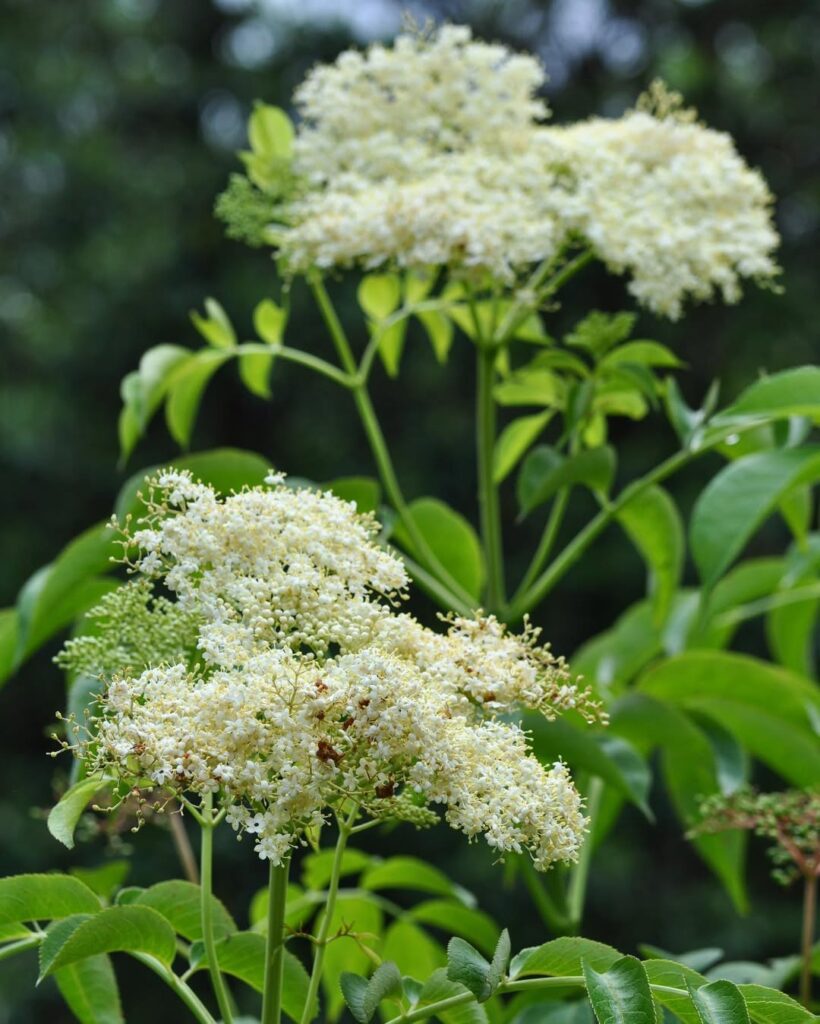
Elderberry (Sambucus canadensis) is a graceful, deciduous shrub native to eastern North America that reaches 12-15 feet tall and wide with an arching, loose form. This fast-growing Kentucky native produces stunning clusters of white flowers in late spring, followed by abundant purple-black berries that provide essential food for wildlife. The pinnately compound leaves and dense growth habit make it an excellent choice for naturalistic landscapes, wildlife gardens, and ecological restoration projects.
Beyond its ecological value, elderberry offers culinary versatility with edible flowers and berries rich in vitamin C. The flowers can be used for fritters and teas, while the cooked berries make excellent jams, jellies, and sauces. This adaptable shrub thrives in various conditions from woodland edges to sunny gardens, making it ideal for Kentucky gardeners seeking low-maintenance native plants that support local wildlife while providing seasonal interest. The plant is particularly valuable for erosion control in moist sites and can even be used as an effective hedge.
- Hardiness: USDA zones 3-9
- Light: Full sun to partial shade; tolerates dappled shade
- Water: Medium to high moisture; tolerates wet conditions and drought once established
- Soil: Adaptable to various soil types; prefers moist, fertile, well-draining soil
- Fertilizer: Low requirements; benefits from organic matter or compost
- Pest/Disease Resistance: Generally pest and disease resistant; very hardy
- Growth Rate: Fast-growing and aggressive
Redbud (Cercis Canadensis)
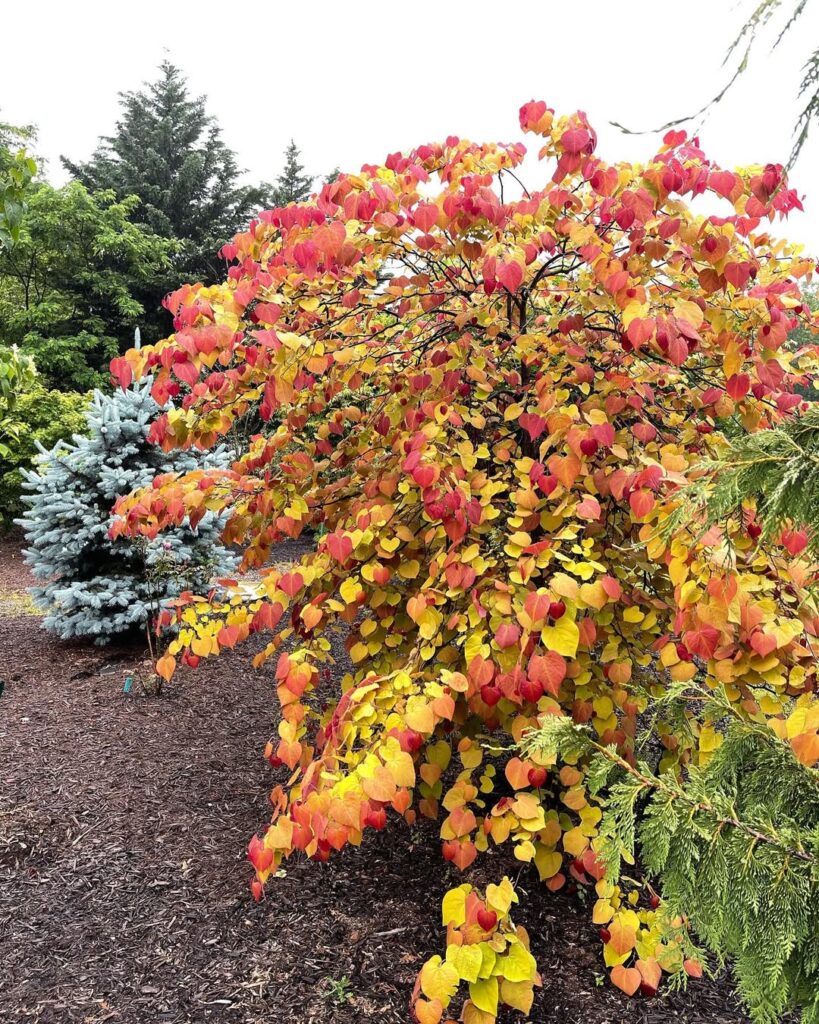
The Eastern Redbud is a stunning native deciduous tree that serves as an excellent addition to Kentucky landscapes. Growing 15-30 feet tall with an umbrella-like crown, this small tree features distinctive heart-shaped leaves and picturesque maroon-purple trunks. Its most notable characteristic is the spectacular early spring display of pink flowers that bloom directly from branches and stems before leaves emerge, creating a breathtaking show that signals the arrival of spring.
As a member of the legume family, Redbud produces clusters of bean-like seed pods that persist through winter. The tree naturally develops multiple trunks unless trained otherwise, and its adaptable nature makes it perfect for urban settings. It thrives as an understory plant and is particularly valuable for its tolerance to juglone, making it an ideal companion for Black Walnut trees. Beyond its ornamental value, Redbud offers culinary possibilities as both the flowers and buds can be harvested and added to salads, breads, and pancakes for their high vitamin C content.
- Hardiness: Zones 4-9
- Light: Full sun to partial shade
- Water: Moderate; drought tolerant once established
- Soil: Adaptable to various soil types; prefers well-draining, alkaline limestone soils
- Fertilizer: Low maintenance; rarely needs supplemental feeding
- Pest/Disease Resistance: Generally resistant to most pests and diseases
- Growth Rate: Moderate to fast
Ninebark (Physocarpus Opulifolius)
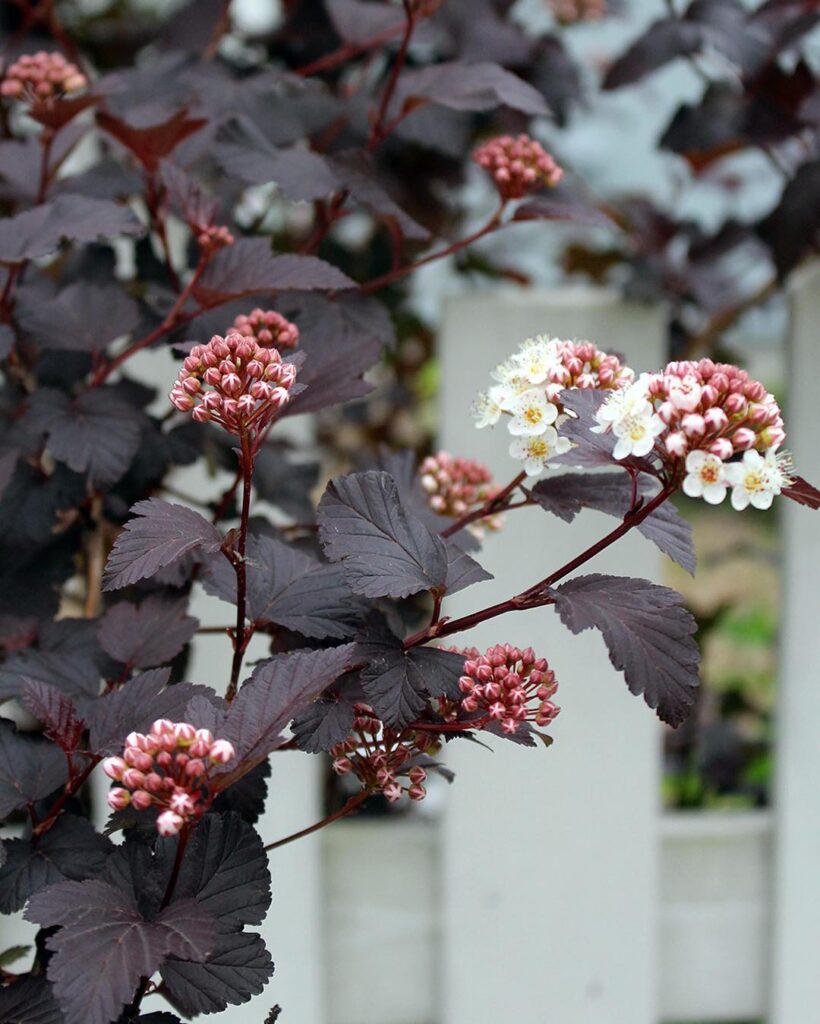
Ninebark (Physocarpus opulifolius) is a versatile deciduous shrub native to eastern Kentucky that reaches 3-10 feet in height with an attractive rounded form. This low-maintenance plant features showy clusters of white to pinkish flowers in late spring, distinctive exfoliating bark that provides winter interest, and persistent fruit pods that benefit wildlife.
As an excellent non-invasive alternative to exotic ornamentals, ninebark supports local ecosystems by attracting pollinators and serving as a host plant for moths. Its adaptability to various soil conditions and strong drought tolerance once established make it ideal for native gardens, wildlife habitats, and erosion control applications. The plant is commonly found along streambanks and woods edges in its natural habitat, making it perfect for naturalizing in similar garden settings.
- Hardiness: Native to eastern U.S. including Kentucky; cold hardy with excellent adaptability
- Light: Full sun to part shade; blooms best and grows denser in full sun locations
- Water: Drought tolerant once established; prefers medium to moist soil conditions
- Soil: Tolerates wide range including rocky, clay, and well-drained soils
- Fertilizer: Low maintenance; no special fertilization requirements needed
- Pest/Disease Resistance: Naturally insect and disease resistant with minimal issues
- Growth Rate: Fast-growing with rapid establishment and quick landscape impact
Serviceberry (Amelanchier Canadensis)
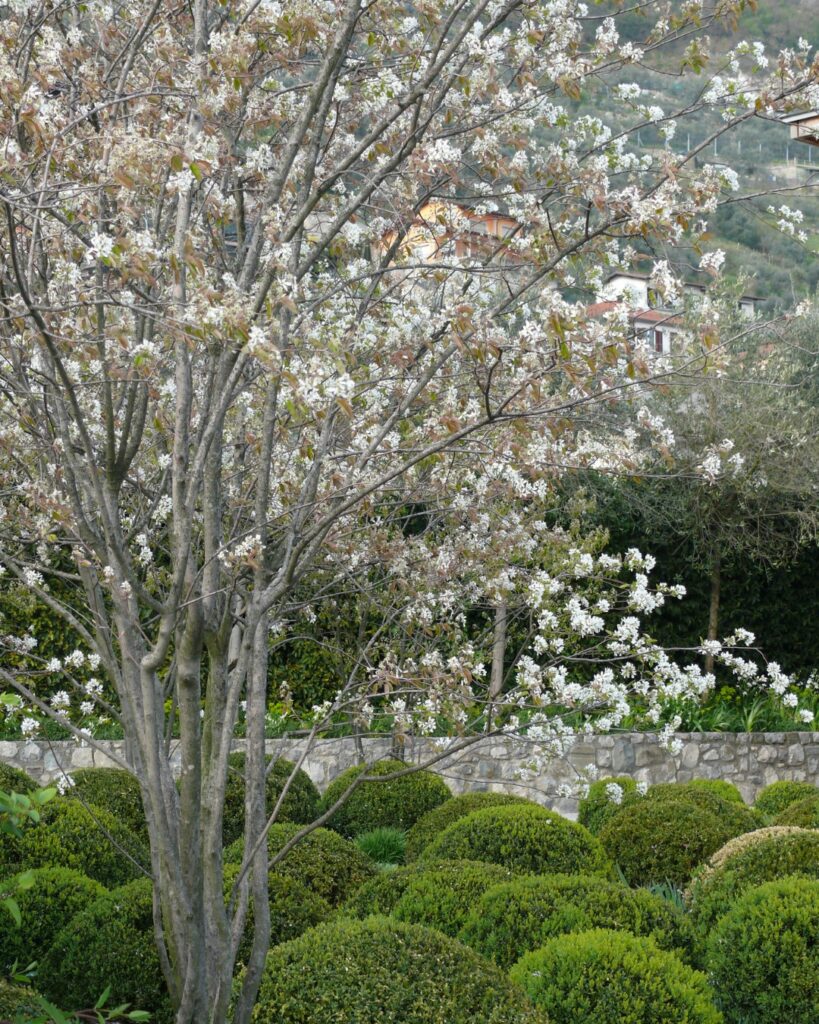
Serviceberry (Amelanchier Canadensis) is a versatile native deciduous shrub or small tree that reaches 15-25 feet tall and wide. This understory gem produces delicate white flowers in April before leaves emerge, followed by edible crimson fruits in May that attract native birds. With its smooth gray bark, upward-sloping branches, and vibrant orange to rusty-red fall foliage, Serviceberry provides four-season interest.
As an excellent native alternative to invasive Bradford Pear, Serviceberry can be pruned as either a multi-stemmed shrub or single-trunk tree. Multiple varieties are available, and while it may experience some cosmetic pest issues, it remains a valuable addition to Kentucky landscapes, supporting local wildlife while offering exceptional aesthetic appeal that sadly remains underutilized in residential design. The plant can be easily propagated from hardwood or softwood cuttings for gardeners looking to expand their native plant collection.
- Hardiness: Zones 3-8, native to Eastern North America including Kentucky
- Light: Full sun to partial shade, excellent as understory tree
- Water: Moderate water needs, drought tolerant once established
- Soil: Adaptable to various soil types, prefers well-drained conditions
- Fertilizer: Minimal fertilizer requirements as native species
- Pest/Disease Resistance: May experience various issues but typically cosmetic rather than fatal
- Growth Rate: Moderate growth rate
Selecting the Right Native Plants for Your Garden
Choosing native plants for your Kentucky garden starts with understanding your specific growing conditions, since even the best native species won’t thrive in unsuitable locations. First, determine your USDA zone—Kentucky spans 6a through 7—then assess sunlight exposure and drainage patterns.
Conduct a soil test to reveal pH levels and nutrient content. This information guides both plant selection and necessary soil amendments. Consider your maintenance preferences too; aggressive spreaders like some native grasses require management, while low-maintenance options reduce long-term care.
Match planting techniques to each species’ needs, focusing on proper timing and watering schedules for successful establishment. Start with a manageable garden bed to reduce workload and allow yourself to focus on proper soil preparation, which is the most labor-intensive aspect of creating a native plant garden.
Frequently Asked Questions
When Is the Best Time to Plant Native Kentucky Plants?
Fall’s the ideal planting season for your Kentucky natives. You’ll reduce transplant shock and boost drought resistance. Following these seasonal gardening tips, your plants establish stronger roots before summer heat arrives, requiring less watering.
How Much Do Native Kentucky Plants Typically Cost?
While individual natives cost $13.95-$16.95 each, garden kits offer better native plant pricing at $98-$129 for nineteen plants. You’ll save money through cost comparison—kits provide significant per-plant discounts versus buying separately.
Where Can I Purchase Native Kentucky Plants Locally?
You can purchase native Kentucky plants from local nurseries like Ironweed, Springhouse Gardens, and Junebug’s Natives, or through online retailers such as Garden for Wildlife’s curated collections by zip code.
Do Native Kentucky Plants Require Special Fertilizers or Soil Amendments?
Don’t reinvent the wheel – native Kentucky plants have minimal fertilization needs since they’re adapted to local soil quality. You’ll rarely need special fertilizers or amendments, as excessive nutrients actually harm their natural growth patterns.
How Long Does It Take for Native Plants to Establish?
The establishment timeline for native plants varies considerably based on growth factors like species type and planting method. You’ll see perennial wildflowers take 1-2 years, while container plants establish within one growing season.
